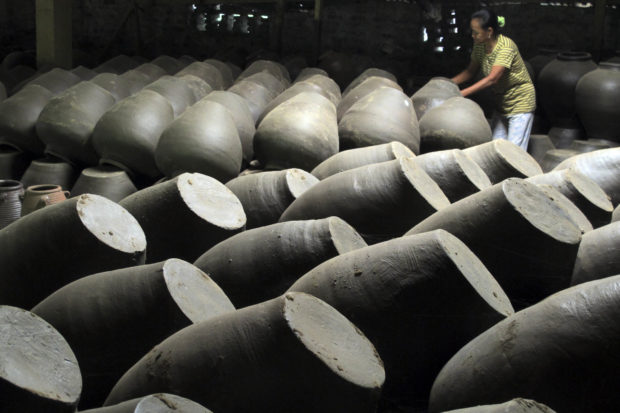
VIGAN POTTERY The city of Vigan in Ilocos Sur is not only famous for its cobblestone streets and Spanish-era mansions, but for its “burnay” (earthen jars) made by local artisans. Vigan, one of
the most popular destinations in northern Luzon, has turned into a “ghost town” due to the absence of tourists and tourismactivities. —NIÑO JESUS ORBETA
BAGUIO CITY, Benguet, Philippines —Beaches and other popular tourist spots in the Ilocos region are being readied for the revival of the tourism industry that is expected to benefit this city and its neighboring provinces.
A “ridge to reef” strategy for this goal was proposed by the city government to the governors of La Union, Pangasinan, Ilocos Sur and Ilocos Norte provinces during a meeting with Tourism Secretary Bernadette Romulo-Puyat here on Tuesday.
The planned tourism corridor, or “tourism bubble,” will allow residents here and adjoining cities and towns to travel exclusively within the Ilocos region amid the coronavirus threat.
Tourist sites in the north Luzon normally draw visitors from Metro Manila and other key cities, which have become epicenters of the disease.
Businesses will thrive from domestic tourists within this corridor until the public health crisis ends, according to Aloysius Mapalo, city tourism officer.But Mapalo said measures to control tourist flow, determine how each destination could enrich a traveler’s experience and ensure profitability should be considered.
Tourism corridor
The provincial leaders have agreed in principle to form the tourism corridor to reopen their leisure industries.
Governors Matthew Manotoc (Ilocos Norte), Ryan Singson (Ilocos Sur) and Amado Espino Jr. (Pangasinan) said they would also explore a possible joint public health security system before they open their areas to tourists.
Tourism has suffered the biggest blow from the quarantine since March that stopped the movement of people across borders.
“Ilocos Sur has no big manufacturing industries to speak of. We rely heavily on tourism,” Singson said.According to him, two hotels in his province have closed while Vigan City, a World Heritage site and one of the most visited destinations, “is like a ghost town today.”
La Union was represented by entrepreneur Jeff Ortega, director of the Department of Tourism regional office and brother of Gov. Francisco Ortega III.
Puyat suggested undertaking an inventory of Ilocos destinations that would be part of the corridor strategy, such as the beaches of San Juan and Bauang towns in La Union, and Pagudpud town in Ilocos Norte.
Manotoc said residents along the corridor needed strong assurances that they would be protected from the coronavirus due to risk of transmission when people cross borders. He asked the governors to help determine the most efficient tests they should use on travelers.
Product exchange
Mapalo said the city government had proposed that tourists take the reverse transcription-polymerase chain reaction test at their own expense, and that travel agencies be tapped as safety officers.
The tourism corridor will also establish a product exchange network that will revitalize the economies in northern Luzon, Manotoc said, adding that traders and manufacturers could exchange Ilocos products like “bagnet” with “ube” or strawberry jams produced in Baguio and Benguet.
While the tourism corridor strategy was being finalized, Baguio Mayor Benjamin Magalong urged residents “to rediscover our own city and be our city’s tourists.”
Allowing tourists back to Baguio would be “gradual, calibrated and based on our degree of confidence.” he said.
—Vincent Cabreza